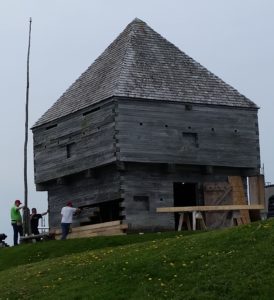 I know I have many readers from Canada, so today I welcome Diane Parkinson to share her research for her new book ‘On a Stormy Primeval Shore‘. Over to Diane.
I know I have many readers from Canada, so today I welcome Diane Parkinson to share her research for her new book ‘On a Stormy Primeval Shore‘. Over to Diane.
In researching my novel set in New Brunswick, Canada, in the eighteenth century, I needed a fort for my heroine’s father to be stationed. Several forts had been built around the Bay of Fundy coast. Unfortunately, none have survived. The French constructed forts during the seventeenth century when France occupied the area they’d named New France. England took possession in 1763 after the Seven Years War (also called the French and Indian War) and built their own forts.
I traveled to the port city of Saint John in New Brunswick in May 2017, and discovered a lone block house on a hill behind the town. Thus, I ferreted out the history.
 In 1777, Brigade-Major Gilfred Studholme was sent to Parr Town (future Saint John) to ensure the settlement’s security. Two years before the American colonies to the south had erupted in rebellion against Britain. American privateers were raiding the harbor and encampments up the St John River.
In 1777, Brigade-Major Gilfred Studholme was sent to Parr Town (future Saint John) to ensure the settlement’s security. Two years before the American colonies to the south had erupted in rebellion against Britain. American privateers were raiding the harbor and encampments up the St John River.
On the limestone knoll that overlooked the harbor, Studholme’s detachment along with local inhabitants built Fort Howe, named for General William Howe, commander of the North American British forces.
The fort was surrounded by a palisade of massive, pointed wooden logs. A blockhouse sat on the west side with a barracks and residences in the center. The Royal Fencible Americans, Studholme’s regiment, manned the blockhouse on the eastern side. The coastal end of the Appalachian Mountains formed a part of the fortifications. Fort Howe provided security, and doled out food during starvation conditions, for the area.
Even the famous—or infamous—Benedict Arnold, traitor to some, hero to others, lived at the fort in the later 1780s. General Arnold had started out on the American side, but then, feeling underappreciated, and underpaid, he joined the British forces.
A fire destroyed Fort Howe in 1819. Two hundred years later I stood on the isolated hill where a plaque commemorates the fort. A reconstructed Block House is the only evidence a great fort once existed here.

I incorporate life at the fort in my novel, On a Stormy Primeval Shore:
In 1784, Englishwoman Amelia Latimer sails to the new colony of New Brunswick in faraway Canada. She’s to marry a man chosen by her soldier father. Amelia is repulsed by her betrothed, and refuses to marry him. She is attracted to a handsome Acadian trader, Gilbert, a man beneath her in status. Gilbert must fight the incursion of English Loyalists from the American war to hold onto his land and heritage. Will he and Amelia find peace when events seek to destroy their love and lives.
Diane Parkinson (Diane Scott Lewis) grew up in the San Francisco Bay Area, joined the Navy at nineteen and has written and edited freelance since high school. She writes book reviews for the Historical Novels Review and worked as a historical editor for The Wild Rose Press. She’s had several historical novels published. Diane lives with her husband in Western Pennsylvania.
Buy Amazon US Buy Everywhere else

How interesting. Apart from reading Diane’s wonderful book, On a Stormy Primeval Shore I know little about New Brunswick’s history.
I know very little about either the place or the period Maggi, so I look forward to finding out more from Diane’s book!
Thanks, Maggi. And thanks to Deborah for hosting me.
A pleasure, Diane. Best of luck with your new release.
A lovely, informative blog. The story amongst my mother’s family is some old aunts looked into their ancestory and came across Mister Arnold. When they saw that they stopped researching, fearing they would dig up some other infamous person whom they would be embarrassed to recognize as their own. I suppose in this case ignorance is bliss.
Fascinating time period and perspective:)